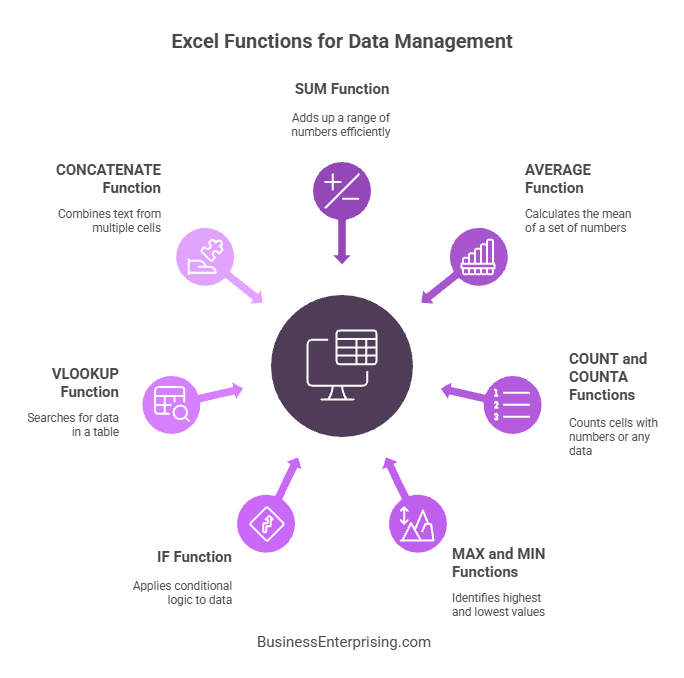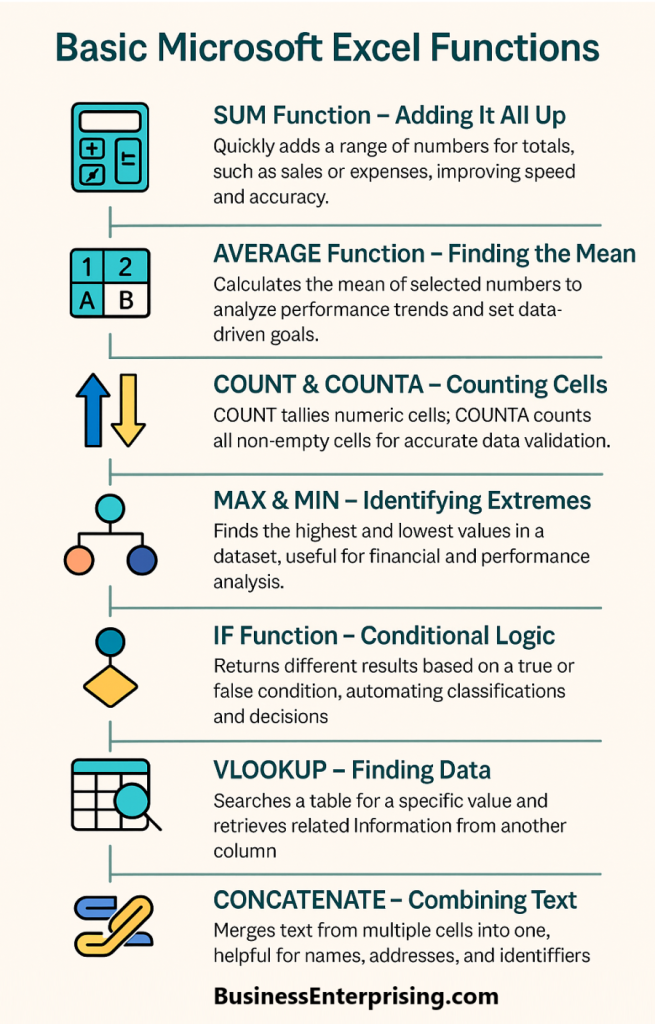
SUM Function: Adding It All Up
The SUM function is one of the most frequently used basic Microsoft Excel functions. It allows users to quickly add up a range of numbers. Whether you are totaling sales or calculating expenses, the SUM function is an efficient way to perform these calculations. To use the SUM function, simply select the cell where you want the result to appear then type “=SUM(“. Afterwards, highlight the range of cells you wish to add. Closing the parenthesis and pressing Enter completes the calculation.
This function not only saves time but also reduces the risk of errors associated with manual addition. For instance, if you have a column of monthly sales figures, using the SUM function to get the total annual sales ensures accuracy and efficiency. Additionally, the SUM function can be combined with other functions to perform more complex calculations.
AVERAGE Function: Finding the Mean
The AVERAGE function is another fundamental tool in Excel, used to calculate the mean of a set of numbers. This function is particularly useful for analyzing data trends and making informed decisions based on average values. To use the AVERAGE function, you select the target cell, type “=AVERAGE(“, and highlight the range of cells you want to average. Completing the formula with a closing parenthesis and pressing Enter provides the average value.
For example, if you are tracking weekly performance metrics, the AVERAGE function can help you determine the average performance over a given period. This insight can inform strategic decisions, such as identifying areas for improvement or recognizing consistent performance. Moreover, understanding the average value of data sets can aid in setting realistic goals and benchmarks for future performance.
COUNT and COUNTA Functions: Counting Cells
The COUNT and COUNTA functions are essential for counting cells that contain numbers or any data, respectively. The COUNT function specifically tallies the number of cells in a range that contain numeric values, while COUNTA counts all non-empty cells. These functions are particularly useful for data validation and analysis.
To use the COUNT function, you select the cell for the result, type “=COUNT(“, and highlight the range of numeric cells. Similarly, using COUNTA involves typing “=COUNTA(” and selecting the desired range. These functions can help track the number of entries in a dataset, ensuring completeness and accuracy. For instance, in a survey dataset, the COUNT function can determine the number of respondents who provided numeric answers, while COUNTA can count all responses, including text entries.
MAX and MIN Functions: Identifying Extremes
The MAX and MIN functions are invaluable for identifying the highest and lowest values in a dataset. These functions are essential for data analysis, helping users quickly find critical data points without manually searching through large datasets. The MAX function returns the largest value in a specified range, while the MIN function identifies the smallest value.
Using these functions involves selecting the result cell, typing “=MAX(” or “=MIN(“, and highlighting the relevant range. These functions are particularly useful in financial analysis, such as determining the highest and lowest sales figures over a period. By identifying these extremes, businesses can better understand their performance dynamics and address any anomalies or trends.
IF Function: Conditional Logic
The IF function is a powerful tool in Excel, allowing users to apply conditional logic to their data. This function performs a specified action based on whether a given condition is true or false. The syntax for the IF function is “=IF(condition, value_if_true, value_if_false)”.
For example, if you want to categorize sales figures as “High” or “Low” based on a threshold, the IF function can automate this classification. Typing “=IF(A1>1000, ‘High’, ‘Low’)” in a cell will return “High” if the value in cell A1 is greater than 1000 and “Low” otherwise. This function is extremely versatile and can be used for various tasks, such as data validation, financial modeling, and reporting.
VLOOKUP Function: Finding Data
The VLOOKUP function is essential for searching for a value in a table and returning a corresponding value from a specified column. This function is particularly useful for merging data from different sources and creating detailed reports. The syntax for VLOOKUP is “=VLOOKUP(lookup_value, table_array, col_index_num, [range_lookup])”.
To use VLOOKUP, you specify the value you want to look up, the table range containing the data, the column number of the value to return, and whether you want an exact or approximate match. For instance, in a product inventory table, VLOOKUP can quickly find the price of a specific product by looking up the product ID. This function streamlines data retrieval processes, enhancing efficiency and accuracy in data management.
CONCATENATE Function: Combining Text
The CONCATENATE function, now often replaced by the “&” operator or the TEXTJOIN function, is used to combine text from multiple cells into one cell. This function is useful for creating full names from first and last names, merging addresses, or generating unique identifiers.
To use CONCATENATE, you type “=CONCATENATE(text1, text2, …)” or use the “&” operator as in “A1 & B1”. This function simplifies data management tasks, particularly when dealing with text-heavy datasets. For example, merging first names in column A with last names in column B using “=A1 & ‘ ‘ & B1” creates a full name in the target cell.
Conclusion
Mastering basic Microsoft Excel functions is essential for anyone looking to improve their efficiency and accuracy in data management. Functions like SUM, AVERAGE, COUNT, MAX, MIN, IF, VLOOKUP, and CONCATENATE provide powerful tools for performing various tasks, from simple calculations to complex data analysis. By understanding and utilizing these functions, users can streamline their workflows, enhance decision-making, and unlock the full potential of Excel.
In conclusion, investing time in learning these basic Microsoft Excel functions pays significant dividends in productivity and proficiency. As you become more comfortable with these tools, you will find that they open up new possibilities for data analysis and business insights. Whether you are a beginner or looking to refresh your skills, mastering these basic functions is a critical step toward Excel proficiency and professional success. For more information, consider our Microsoft Excel Online Course.


